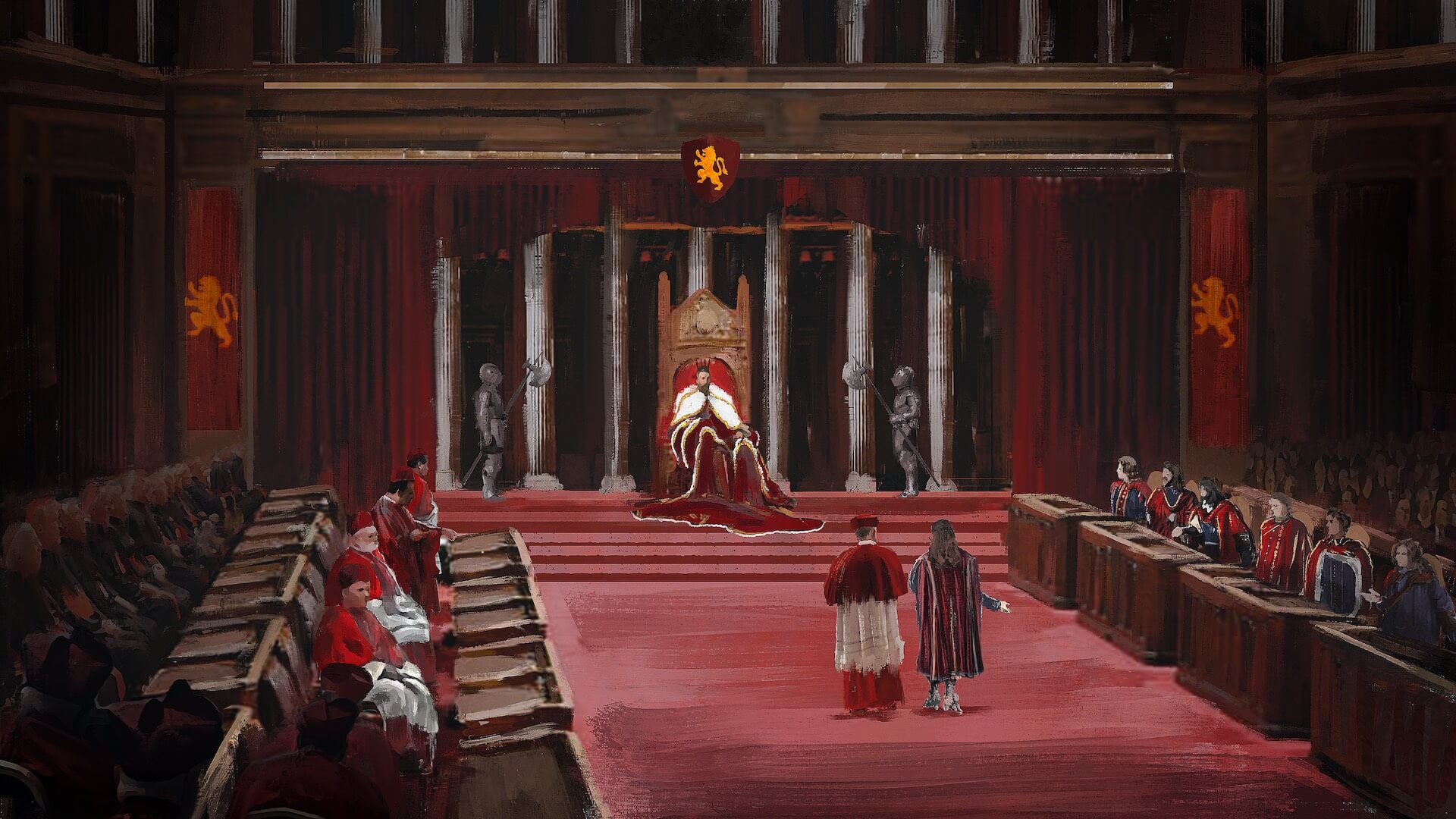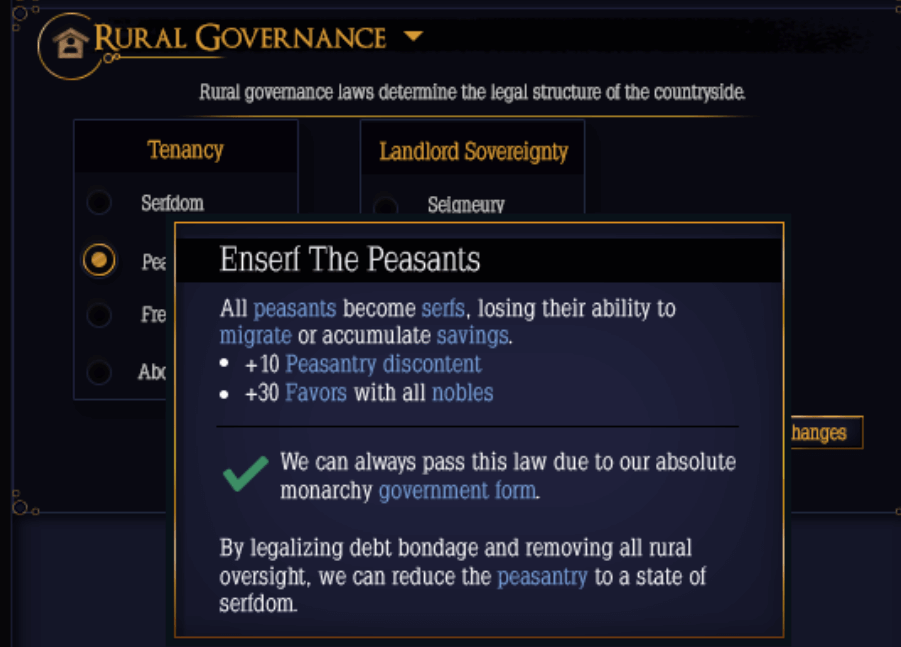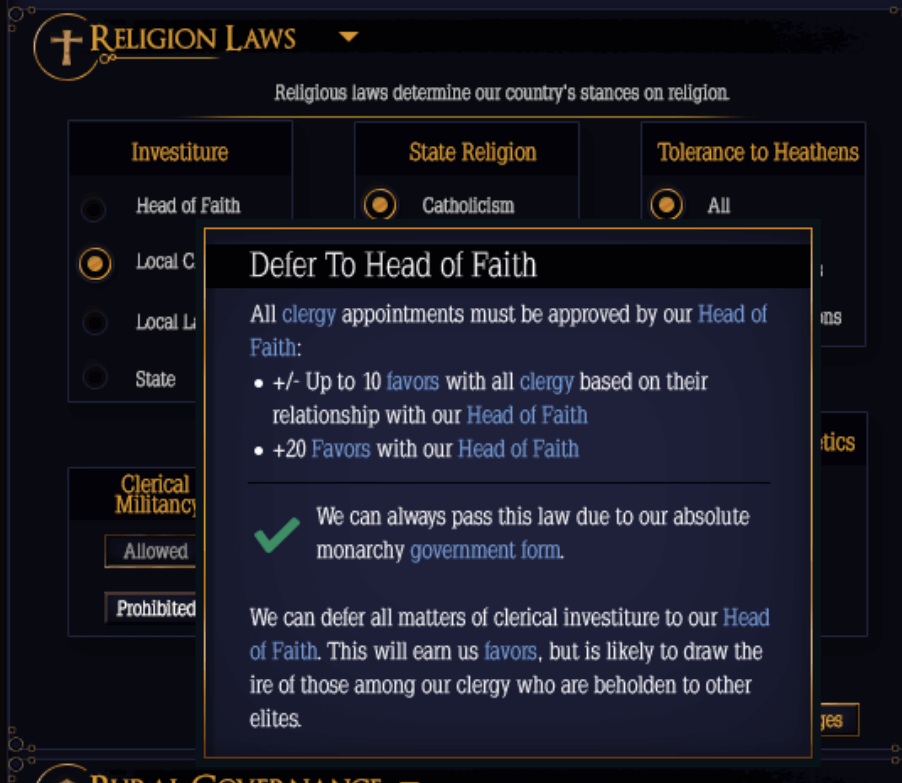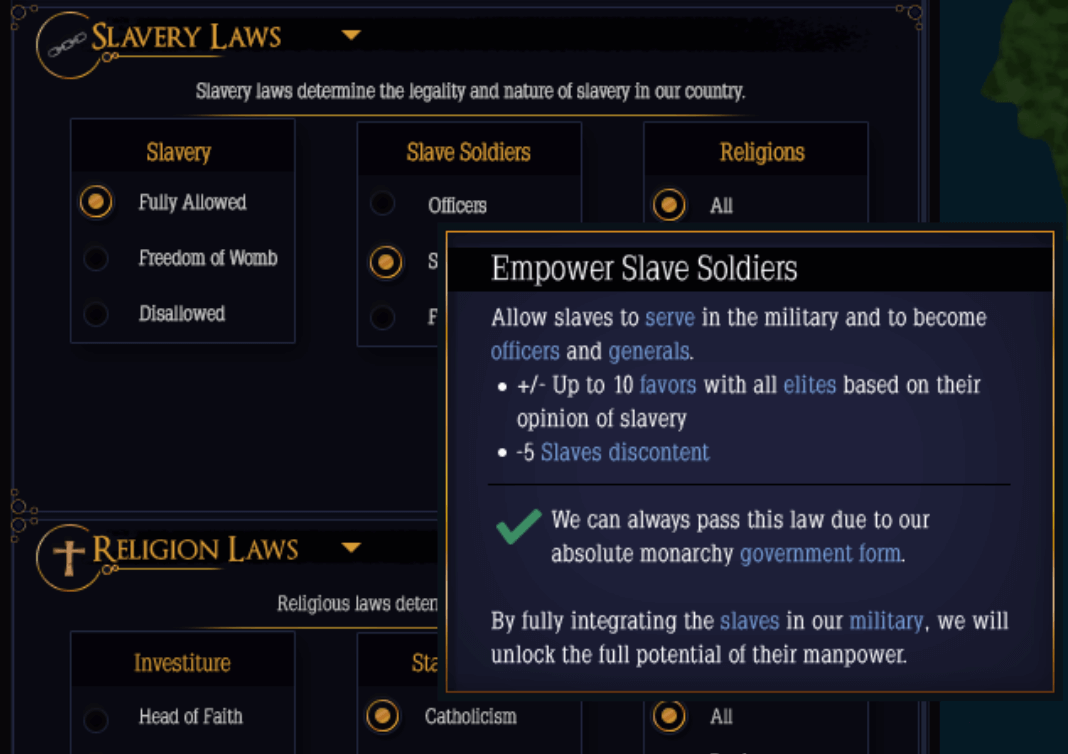Dev Diary #3: Countries
15:10, 26 Feb 2022

Hello everyone and welcome to Grey Eminence’s third development diary!
This time around, we’re going to explore how countries work in Grey Eminence. A country is any polity that rules over a given set of tiles. It’s what you, the player, will attempt to control and direct throughout the game.
The 600-year span between 1356 and 1956 saw the rise and fall of a staggering variety of states, many of which weren’t fully independent. In Grey Eminence, countries (usually) aren’t monoliths: the kingdoms and empires of 1356 are composite states with multiple layers of vassals, each of which is a playable country in its own right. The exact interactions between subject countries and their overlords will be the subject of a separate dev diary, but we felt it was a good idea to clear this up now.
For now, we’ll describe the inner workings of a country in Grey Eminence. In order to properly represent the diversity of states across the game’s 6-century timeframe, we’ve made countries as customizable as possible through several interlocked systems.
Government Forms
At the highest level, we define a country by its form of government. Grey Eminence has 32 different government forms, defined by two related parameters: source of legitimacy and distribution of power.
Source of legitimacy is pretty self-explanatory: it tells us what a country’s population and elites consider important when evaluating their ruler’s legitimacy. The four potential sources of legitimacy are dynastic, religious, electoral, and tribal.
Countries with a dynastic source of legitimacy are monarchies; they’re the most common government form in 1356. Having a dynastic source of legitimacy unlocks several notable features. All monarchies have a ruling dynasty, which is comprised of all characters in the world that belong to the current ruler’s dynasty. Monarchies also have a royal family, which consists of the ruler’s parents, grandparents, siblings, children, and so on (even if they belong to a different dynasty).
The religious source of legitimacy is tied quite closely to religion (duh). The various religious denominations of Grey Eminence have unique mechanics that we’ll describe in another dev diary, but specifically with regards to government form, this source of legitimacy dictates that the country’s ruler must be a member of the clergy.
Rulers of countries with an electoral source of legitimacy derive their authority solely through the outcome of an election, which can take various forms. Note that these elections needn’t be public; in fact, the vast majority of elections in 1356 were restricted to a select few elites, both in terms of candidacy and participation.
The final source of legitimacy is tribal. It reflects societal structures where kinship and belonging to a particular culture were prioritized more highly than dynastic ties. This category is perhaps the most fluid, since it tries to represent countries from radically different walks of life. Nevertheless, we’re departing from other grand strategy games by not artificially handicapping tribal countries simply due to them being tribal. This idea of tribal equaling primitive permeates popular consciousness, despite significant efforts from historiographers to stamp it out, so we’re doing our part to dispel it.
The second determinant of government form is distribution of power. This parameter tells us who a country’s power-holders should be. I say “should” because the reality of a country’s power distribution might diverge significantly from what the law says it should be. The options here are: autocratic, oligarchic, and democratic.
Under the autocratic power distribution, a country’s ruler is the sole legal authority. Of course, the elites and population might still wield significant de facto power, but their ability to exercise it through legal means is limited. This can be a blessing or a curse: in the right hands, absolute power can be a tool of progress… yet it can just as easily cause terrible harm. As a player guiding an autocratic country, you’ll want to be very careful with who you allow on the throne. In some cases, you might even prefer going through usurpation and civil war than suffering the predilections of a misguided ruler.
The oligarchic distribution of power is the most common one in 1356. It grants one of the country’s elites enough de jure power to act as a counterweight to the ruler. This usually manifests in an assembly, council, or parliament; the exact structure varies from country to country (more on that a bit farther down), but importantly, its membership isn’t necessarily limited to characters from the oligarchic elite.
The final distribution of power is democratic. It involves granting de jure political power to (at least some part of) the population and is closely linked to the rise of constitutionalism and political parties. However, while enfranchising the people might appease their hunger for representation, one can never satisfy everyone. Thus, once the representative cat is out of the bag, you’ll find that there’s always someone unhappy enough with the status quo to meddle in your plans.
I’m sorry, I lied when I said there were only three distributions of power. We actually have a fourth, special one: anarchic. This one alters gameplay so much that we would need a full-length dev diary just to describe it, so for now we’ll leave it at that.
| Dynastic | Religious | Electoral | Tribal | |
| Anarchic (rule of none) |
? | ? | ? | ? |
| Autocratic (rule of one) |
Absolute Monarchy | Absolute Theocracy | Autocratic Republic | Autocratic Chiefdom |
| Oligarchic (rule of few) |
- | - | - | - |
| Nobility | Aristocratic Monarchy | Aristocratic Theocracy | Aristocratic Republic | Aristocratic Chiefdom |
| Clergy | Theocratic Monarchy | Limited Theocracy | Theocratic Republic | Theocratic Chiefdom |
| Merchants | Plutocratic Monarchy | Plutocratic Theocracy | Plutocratic Republic | Plutocratic Chiefdom |
| Military | Stratocratic Monarchy | Stratocratic Theocracy | Stratocratic Republic | Stratocratic Chiefdom |
| Tribes | Tribal Monarchy | Tribal Theocracy | Tribal Council | Tribal Chiefdom |
| Democratic (rule of many) |
Constitutional Monarchy | Constitutional Theocracy | Constitutional Republic | Tribal Republic |
Combining all the sources of legitimacy and distributions of power gives us a neat matrix of all the possible government forms.
Laws
Of course, there is a lot more to defining a country than just its government form, so we’ve broken down as many individual aspects of a country’s structure as possible into different laws. Each law has multiple options that affect how a particular mechanic in the country might work. In 1356, most countries have just over 30 laws, each with around 3 options on average, but as the game progresses there will be a lot more you can unlock via technology.
The wide variety of laws we have included allows us to make each country feel unique to play (from a mechanics perspective). So, without further ado, let’s explore a few of our laws and their potential impacts!
The first law we’ll look at is tenancy. It determines what (if any) rights are afforded to a country’s peasantry. Obviously, this law is only available to countries with the concept of peasantry, which is closely tied to feudalism and the nobility, so you won’t have access to it if you’re playing, say, a tribal chiefdom in Mongolia or a constitutional republic that has abolished feudal structures.

The four available tenancy laws are: serfdom, peasantry, free tenancy, and abolished.
Under serfdom, your country’s peasants (renamed to serfs) have virtually no rights. They cannot migrate voluntarily, nor can they accumulate savings. Since serfdom is a form of indentured servitude, serfs don’t really have wages. Instead, they’re given just enough food to not starve – and if there isn’t enough food for everyone, well, that’s their problem.
Peasantry is the default tenancy law in 1356. Unlike serfs, peasants are afforded some protections from the excesses of the nobility: in theory, they are allowed to migrate, though few are likely to attempt it unless faced with truly extreme circumstances. Peasants can accumulate wealth, but they can’t own land so buying themselves out of peasantry status isn’t an option. In contrast to serfs, peasants have at least some access to education, especially if it’s provided by the clergy (to whom they’re most likely paying tithes anyway). You shouldn’t expect the peasantry to be a beacon of innovation, but they might still be useful for pushing agricultural techs along.
With free tenancy, the peasants (renamed to tenants) are given much more opportunity. They’re legally protected from high feudal dues and obligations, and if they’re successful enough, they might even buy out their landlords. Doing so makes them freeholders – commoners who own the land they work on. To be clear, freeholders aren’t a separate social class; they’re still commoners, but with the added benefit of keeping all the profits of their labor. In the absence of elite and state intervention, a country with the free tenancy law (and a moderately successful rural sector) should see a rising trend of freeholding.
The final tenancy law fully abolishes tenancy, immediately elevating all peasants into fully-fledged commoners. Emancipation of the peasants usually comes with significant consequences, especially for countries that don’t go through the intermediate step of free tenancy, but that’s a topic for another time.
For our next law, we’ll take a look at clerical investiture. This was a very hot topic in Medieval Europe (and other places!) and was the source of numerous conflicts.

The investiture law has four options: head of faith, local clergy, local laity, and state.
When a country has the head of faith investiture law, all clergy characters in that country are nominally appointed by the head of faith. They key word here is nominally: in reality, offices were often sold to the highest bidder as a source of income – a practice known as simony. A head of faith who cannot exercise his authority runs the risk of creating a revolving door between the elites and the clergy, as happened historically in many Catholic countries around Europe. Of course, investiture laws are available to all countries, not just Catholic ones, although head of faith investiture specifically requires your country’s denomination to have a head of faith (duh).
With the local clergy investiture law, all clerical appointments are handled by the local clergy elite. In practice, this usually results in an entrenched and conservative clergy that will strive for as much autonomy as possible. If left unopposed by the state and the other elites, a localized clergy can evolve into a shadow state in its own right.
Under the local laity investiture law, lay people and elites are responsible for clerical appointment (and can be appointed themselves). This particular law can have wildly different outcomes, depending on your country’s political composition and other laws. For example, in a country without a strong elite it might produce a populist clergy that responds strongly to the will of the people, while in a country with strong, but evenly-matched elites it might produce a divided clergy that’s paralyzed by the competing interests of its elite-elected members.
The final investiture law grants the power of clerical appointment to the state. This law allows you to transform simony into a revenue stream for your country and into a lucrative way of rewarding loyal elite characters (or punishing disloyal ones). Of course, wielding state investiture too pragmatically is likely to draw the ire of the members of society who are genuinely pious, so it is a tool best used carefully and in moderation.
The last law we’ll explore today is slave soldiers. It’s one of the laws related to slavery, so naturally it requires slavery to be legal in your country (can’t have slave soldiers without slaves!).

There are three options for the slave soldiers law: forbidden, soldiers only, and officers.
The forbidden law is very straightforward: it prevents any slaves from serving in your country’s military. With the soldiers only law, slaves can join as regular soldiers, but they’re prevented from holding in any leadership positions. And with the officers law, slaves can also serve as officers and generals. Each of these choices can have a significant impact on your military’s composition, strategy, and performance, but we’ll cover these effects in another dev diary.
These are just three of the 30+ laws we’ve planned for most countries in 1356. We have laws for pretty much every important country mechanic, from succession, pensions, and production ownership to state religion, military recruitment, and press freedom. Laws interact with almost every other system in Grey Eminence, so you’ll be seeing them quite frequently in future dev diaries.
Moddability
It’s par for the course that we cover the many ways in which countries can be modded in Grey Eminence. Our world editor includes several tools for adding, removing, or editing countries, which you can use to edit the 1356 start or to populate your own fantasy/alternate start date scenarios. This includes changing country names, flags, borders, government forms, initial laws, and a bunch of other country-related features that we haven’t revealed yet.
We’ve added a special photoshop-style border editor that allows you to change a country’s borders in real-time by simply painting its color across the globe (tile-by-tile or with larger brushes). In case you want to add/remove/modify content in a more programmatic way, we’ve also included a JSON importer/exporter in the world editor. Like the graphical editor, it happens in real-time and doesn’t require you to restart the game.
Of course, laws and government forms are moddable on the system level as well. With some C# intervention, you can link the activation/deactivation of pretty much any mechanic to the presence/absence of a specific law. For example, you can create a law that allows only children to vote in elections (for all you Lord of the Flies fans out there) or you can implement a tax collection law that taxes people based on their tile’s weather. Did it rain on tax day? Twice the tax burden for you!
We’re honestly really excited to see what you guys will come up with for the laws system. I’m sure I can’t even imagine the crazy mods it will spawn. Oh and with regards to modding government forms: from a mechanics perspective, government forms are just a specific combination of two laws (source of legitimacy and distribution of power), so adding/removing forms of government or reworking existing ones is as simple as modifying the underlying two laws.
As a farewell gift, I’ll show you an example of the country editor’s border brushes in action.

Restoring the glory of the Roman Empire has never been easier! The Ottomans will hate you for discovering this one simple trick: that’s right, in the world editor you can change country borders in real-time by simply painting over the globe! As usual, graphics are heavily WIP.
That’s all for this dev diary. We’ve achieved a good pace of development over the past two weeks, so we’re happy to announce a consistent release schedule for future diaries: expect new ones every second Saturday, starting from March 12! In the meantime, stay updated on Grey Eminence by joining our Discord and Subreddit, as well as following us on YouTube, Facebook, and Twitter. Lastly, if you like what you see and would like to support us in developing Grey Eminence, consider becoming a patron on Patreon. Thanks for reading!


 Back
Back